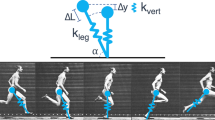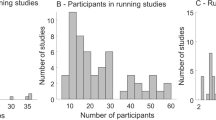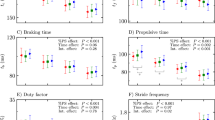Unlike human athletes, these dogs do not need to slow down when racing round a tight bend.
Abstract

Maximum running speed is constrained by the speed at which the limbs can be swung forwards and backwards, and by the force they can withstand while in contact with the ground. Humans sprinting around banked bends change the duration of foot contact to spread the time over which the load is applied, thereby keeping the force on their legs constant1. We show here that, on entering a tight bend, greyhounds do not change their foot-contact timings, and so have to withstand a 65% increase in limb forces. This supports the idea that greyhounds power locomotion by torque about the hips, so — just as in cycling humans — the muscles that provide the power are mechanically divorced from the structures that support weight.
This is a preview of subscription content, access via your institution
Access options
Subscribe to this journal
Receive 51 print issues and online access
$199.00 per year
only $3.90 per issue
Buy this article
- Purchase on Springer Link
- Instant access to full article PDF
Prices may be subject to local taxes which are calculated during checkout

Similar content being viewed by others
References
Greene, P. R. J. Biomech. 20, 667–680 (1987).
Weyand, P. G., Sternlight, D. B., Bellizzi, M. J. & Wright, S. J. Appl. Physiol. 89, 1991–1999 (2000).
International Association of Athletics Federations http://www.iaaf.org/news/kind=4/newsId=24423.html (2005).
Alexander, R. McN., Maloiy, G. M. O., Hunter, B., Jayes, A. S. & Nturibi, J. J. Zool. Lond. 189, 135–144 (1979).
Witte, T. H., Knill, K. & Wilson, A. M. J. Exp. Biol. 207, 3639–3648 (2004).
Gray, J. Animal Locomotion (Weidenfeld & Nicolson, London, 1968).
Alexander, R. McN., J. Zool. Lond. 173, 549–573 (1974).
Lee, D. V., Bertram, J. E. A. & Todhunter, R. J. J. Exp. Biol. 202, 3565–3573 (1999).
Gregersen, C. S., Siverton, N. A. & Carrier, D. R. J. Exp. Biol. 201, 3197–3210 (1998).
McGuigan, M. P. & Wilson, A. M. J. Exp. Biol. 206, 1325–1336 (2003).
Author information
Authors and Affiliations
Corresponding author
Ethics declarations
Competing interests
The authors declare no competing financial interests.
Supplementary information
Supplementary movie 1 'bend'
Head-on view of three greyhounds at the end of the first bend. The mechanical 'hare' can be seen in the foreground towards the end of the clip. Filmed at 500 frames per second, displayed at 1/50th speed. (QT 4768 kb)
Supplementary movie 2 'straight'
Side-on view of a greyhound at the start of the second straight. (QT 1626 kb)
Rights and permissions
About this article
Cite this article
Usherwood, J., Wilson, A. No force limit on greyhound sprint speed. Nature 438, 753–754 (2005). https://doi.org/10.1038/438753a
Published:
Issue Date:
DOI: https://doi.org/10.1038/438753a
This article is cited by
-
Biomechanics of predator–prey arms race in lion, zebra, cheetah and impala
Nature (2018)
-
Locomotion dynamics of hunting in wild cheetahs
Nature (2013)
-
Springs, steroids, and slingshots: the roles of enhancers and constraints in animal movement
Journal of Comparative Physiology B (2013)
-
Flying in a flock comes at a cost in pigeons
Nature (2011)
-
The evolutionary continuum of limb function from early theropods to birds
Naturwissenschaften (2009)
Comments
By submitting a comment you agree to abide by our Terms and Community Guidelines. If you find something abusive or that does not comply with our terms or guidelines please flag it as inappropriate.



